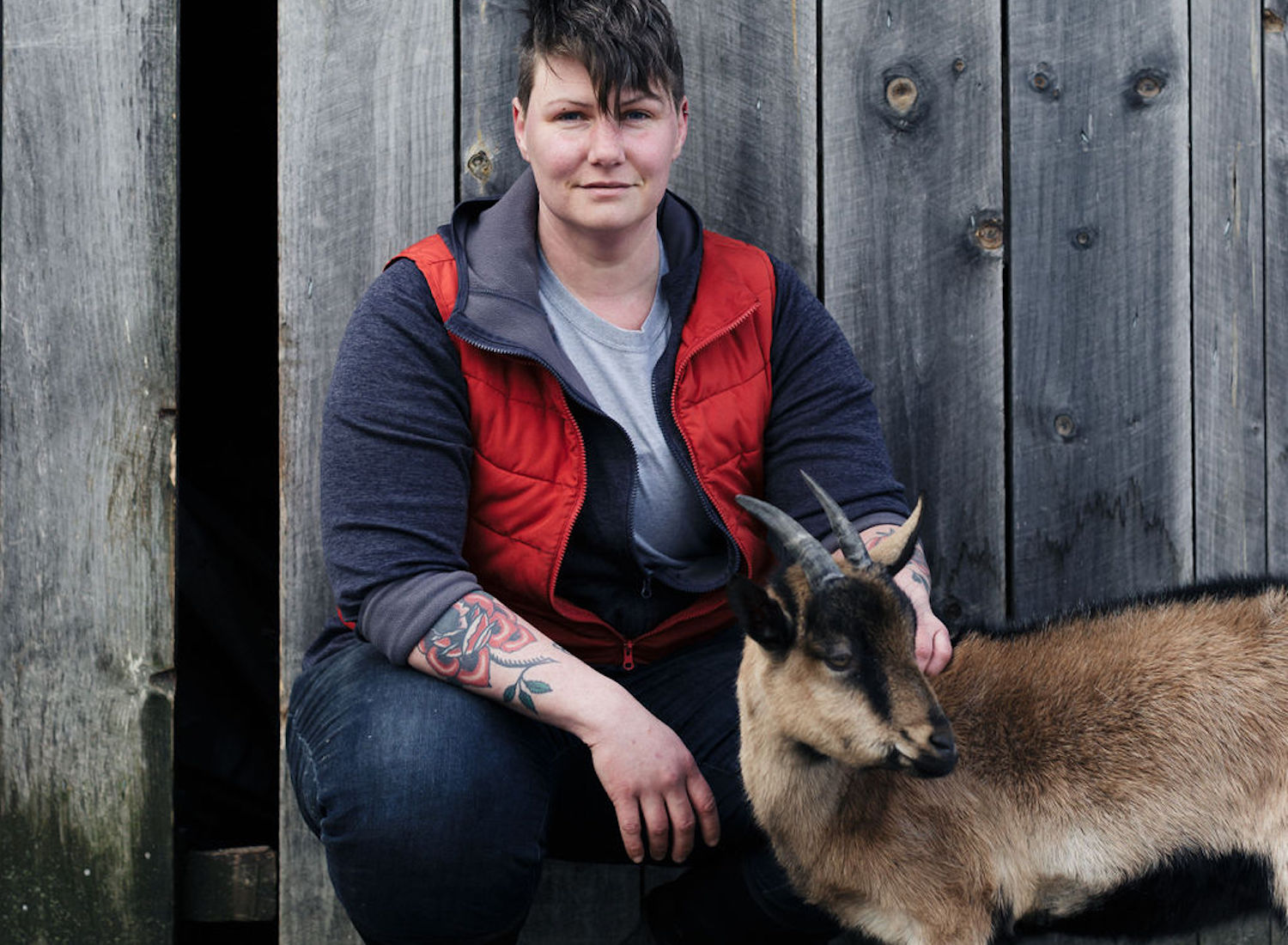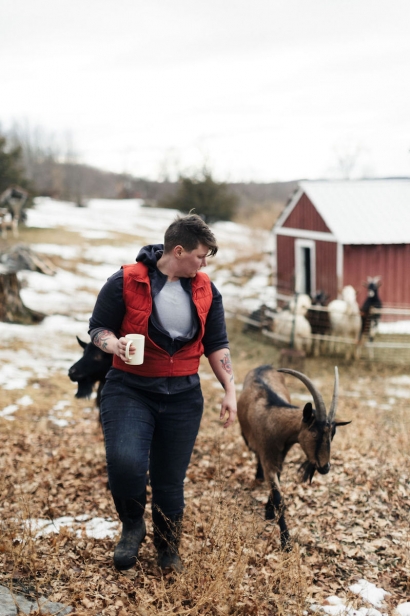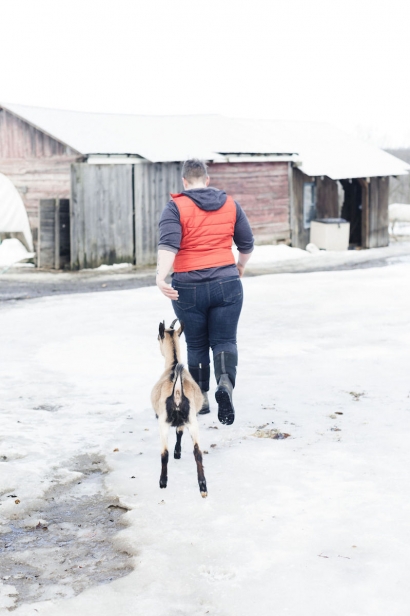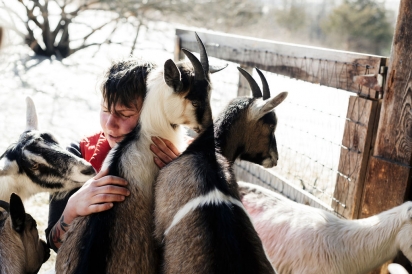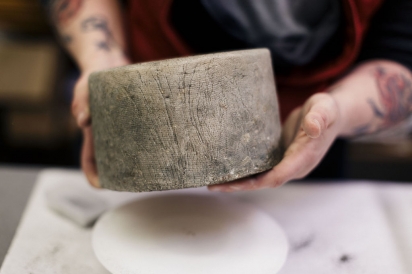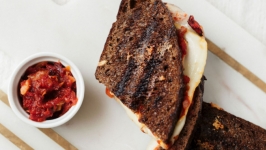Lee's Got Moxie
HELP WANTED: Work 16–22 hours a day, 7 days a week. Sleeping arrangements: a bed next to a semi-paralyzed goat requiring multiple feedings a night. Pay: none. Benefits: spiritual and mental, plus cheese (the first two only if you don’t lose your faith or go insane from burnout).
Why would a former globe-trotting wine consultant with a closetful of bad-ass black leather sign up for this?
“I just wanted to be happy,” Lee Hennessy says, grinning conspiratorially over a large order of frites and a Nine Pin Cider at Ravenous Crepes, and acknowledging the seeming irrationality of their statement.
“On paper, I had it made,” they acknowledge, explaining that they grew up outside of Albany, attended SUNY Purchase, and after graduating with a communications degree, hightailed it first to Munich then to Hollywood, where they worked their way up from the mailroom to a junior agent at a major studio.
When Hennessy’s agency cleaned house after the 2008 financial meltdown, they knew they wanted out of Hollywood, but they didn’t know where they wanted to land. Almost accidentally, they ended up launching a new career from their nascent wine blog, after producers and sellers found their point of view compelling and potentially remunerative. Before they could say blaufränkisch, Hennessy had become the voice of a #thirsty millennial generation, and was getting flown around the world at age 27 to tell winemakers and wine sellers how to talk to their famously brand-and-tradition-averse cohorts.
“I was very successful,” they acknowledge. “Wine Enthusiast, Ad Age, the Washington Post had featured me, and I got to spend time with amazing winemakers in Napa regularly. But by the time I moved back into an executive position with a media company, I was totally burnt out and completely unhappy.”
“I was in Provence visiting vineyards for work, feeling, as ridiculous as this may sound, profoundly depressed,” they recall. “The attaché who was ferrying me around—we’d become friends—asked me what I actually wanted to do. I said, ‘go to a goat fromagerie.’”
Hennessy says they had become “obsessed” with the artisanal cheese movement and was curious to see how the French, after whom many American farmstead cheesemakers modeled themselves, ran their operations. Little did they know where that fateful barnyard peek-a-boo would lead.
After seeing a goat operation firsthand, something inside of Hennessy shifted, and Hennessy’s heart was set on creating a goat cheese operation. Still, despite believing they’d finally discovered where they wanted their career to go, the road from goat love to goat business was as clear as the mud squelching under their happy, nuzzling goats’ hooves. Because while they had an enviable career, Hennessy didn’t have enough bank to afford a career change and cross-country move without a radical lifestyle adjustment.
Hennessy’s first step was quitting their job and moving home. This was 2014. They didn’t say a word to anyone, including their parents, about the new plan to launch a creamery, Hennessy just told them they needed time to figure out their next step.
“I had no idea how I’d do it, I just knew I’d get there eventually,” they admit. They landed a job at Coach Farm in Pine Plains, commuting an hour-and-a-half each way. The pay was a serious step down— we’re talking minimum wage here—but Hennessy loved it, and that, they reveal, was more rewarding than anything their formerly highpowered, well-compensated gigs could offer. Hennessy was in charge of the baby goats for a herd of 1,000, and while they were there, Hennessy learned how to help mama goats give birth, how to care for newborns and how to bottle-feed the babies.
“I was turning the lights off in one of the long barns there and just turned around and saw all of the baby goats I cared for,” they explain. “Mothers talk about that first moment of holding their baby, of feeling this infinite capacity for love. This feeling that they’d do anything for this creature. I don’t have human kids, but that’s how I felt from that day on, about goats.”
About a year into their work there, much of the staff was laid-off due to a change in how the farming side of the business was managed, and for a time they floated, working odd jobs at goat and horse farms, selling cheese and learning the retail trade under Eric Paul, former owner of The Cheese Traveler.
They kept thinking, digging, researching. After about a year, their nose for business led Hennessy to the Agricultural Stewardship Association. They called the ASA, sketched out their impressive business background, and the experience they’d garnered both at farms and behind the cheese counter, and just baldly asked for help.
“The ASA was incredibly open and creative,” they say. “They made a number of suggestions and put me in touch with several agricultural organizations designed to help young farmers just starting out.”
Through the American Farmland Trust’s Hudson Valley Farmlink (now the New York Farmlink), they connected with a number of retiring farmers who were hoping to pass along their businesses, intact, to would-be farmers. One such set of retiring cheesemakers was David and Liza Porter, who had developed a 46-acre livestock and cheese business called Longview Farm in Argyle. Around the same time, Hennessy was introduced to Dirt Capital, which invests in farmland in partnership with sustainable farmers across the Northeast. After working with both the couple and Dirt Capital between October 2016 and March 2017, they came to an agreement on how to transition the farm as smoothly as possible.
Dirt Capital bought the actual farm from the Porters, which included the residence, and Hennessy bought the business. Th e farm contains pasture, with fencing and summer sheds, barns for winter housing, a milking parlor, milk room, cheesemaking room and cheese storage room.
It’s a win-win-win for Hennessy, Dirt Capital and the retiring farmers; without their financial boost, Hennessy couldn’t have managed the lump down payment, and now they have two options to buy.
And the outgoing farmers can rest easy knowing their hard work is being continued.
Moxie Ridge Farm is as small-scale as it can be, while still being Hennessy’s sole source of income. They are the only employee, aside from their team of Shire horses, Sam and Charlie. In addition to tending their mixed herd of 50 goats (Alpine, Saanen and Nigerian dwarf) about half of which can be milked. They also raise free-range chickens and pigs and sell their eggs and meat, along with their fresh and aged varieties of cheese.
“We’ve been really lucky, and we haven’t lost a single baby goat,” they say. “One was stillborn, and one, Sparkles, had several health complications during growth and developed goat polio, which is an extreme thiamine deficiency in goats.”
While some farmers may have opted to let nature take its course, Hennessy brought Sparkles into their home. Sparkles is partially paralyzed and needs shots, a lot of TLC and extra feedings, all of which Hennessy dutifully and (for the most part) joyfully performs, even on Union Square Market days, when Hennessy gets up at 2am to drive to Manhattan and returns home around 11pm. As of the New Year, Sparkles recovered completely and is getting a few extra feedings, but is able to scamper along with her horned brethren in Argyle’s pastures (and sleep all by herself!).
It’s not an easy life, but Hennessy seems to like it that way. Some may even say Hennessy encourages it. Perhaps unsurprisingly for a wine and then cheese maven, Hennessy is singularly focused on terroir.
“All of the Moxie herd is raised on pasture during grazing season, on local hay during winter, and gets their diet supplemented with locally raised non-GMO grain,” they explain. “All of their food comes from within 10 miles of our pastures, so the terroir of Argyle is imparted in the cheese.”
Yet, they take it a step further. “I think about terroir on the microscopic level,” Hennessy says, without a glimmer of irony in their slate-gray eyes. “I work with native and classic cultures and use super traditional cheesemaking techniques that allow the full flavor of the goat’s milk and their diet to express itself.”
An essential component of this is their practice of hand-milking the goats twice a day. “Hand-milking delivers a different flavor than machine milking, because the process picks up different cultures from the air in the farm, which the commercial process of milking eliminates,” Hennessy says.
Now, before you run out to your favorite cheesemonger and demand some Moxie in your life, remember, this is Hennessy we’re buying from. If they’re going to be bottle-feeding a paralyzed goat in the middle of the night to bring you their treasures, Hennessy’s going to ask for you to do your part. As of now, Moxie is only available at the Union Square Greenmarket in Manhattan on Fridays, and at the Saratoga Springs Farmers Market on Saturdays.
WHAT’S IN MOXIE’S LARDER
Whey-Fed Pork The pigs dine on excess whey from the cheesemaking process, a practice common to sustainably minded farms that many (including Hennessy) believe makes their meat taste extra juicy. The heritage-cross hogs also eat from the forest and pasture on their farm and locally grown non-GMO grain, and are finished on acorns and hickory nuts.
Eggs All of the chickens are named Susan, Rhonda or Betty, and they all forage around for bugs and goodies in the grass, then supplement those delights with non-GMO grain and a protein shot of whey.
Goat’s Milk This pasteurized milk is slightly sweet and does not have a “goaty taste,” because fabulous goats make fabulous milk, Hennessy explains.
Goat Cream Cheese A decadent schmear a million miles from Philadelphia.
Chèvre Hennessy’s prime joy. It’s the purest expression of the milk, and the one whose flavor shifts most with the season and the goats’ diet.
Fresh Bulgarian Feta Tangy, salty and more creamy and delicate than Greek feta.
Sutherland A cultured dairy drink made from goat’s milk. With live active culture and healthy protein, it’s a gut bomb your stomach will love.
Valencia A pyramid-shaped dual rind cheese with a snow-white interior and liquid cream line. Drama queen! Aged for about two weeks.
Cannonball Another dual-rind lady, and this one is a diva. The Loire-style fromage features firm mineral structure, a light as cloud interior and a creamy lined-layer of smoky ash. Aged for two-plus weeks.
Big Rhonda Raw goat cheese, aged for three months with a mosaic rind. This is a big, bold cheese with a Gouda-meets-Parmesan flavor.
Karner Blue A very special offering, highly seasonal. This cheese is raw, aged and low-moisture, with a mosaic rind.
Nine Pin Cider | @ninepincider
Ravenous Crepes | @ravenouscrepes
Coach Farm | @coachfarm
The Cheese Traveler | @thecheesetraveler
Agricultural Stewardship Association
New York Farmlink
Dirt Capital
Moxie Ridge Farm | @moxieridgefarm
Union Square Market | @unsqgreenmarket
Saratoga Springs Farmers Market | @saratogafarmersmarket


